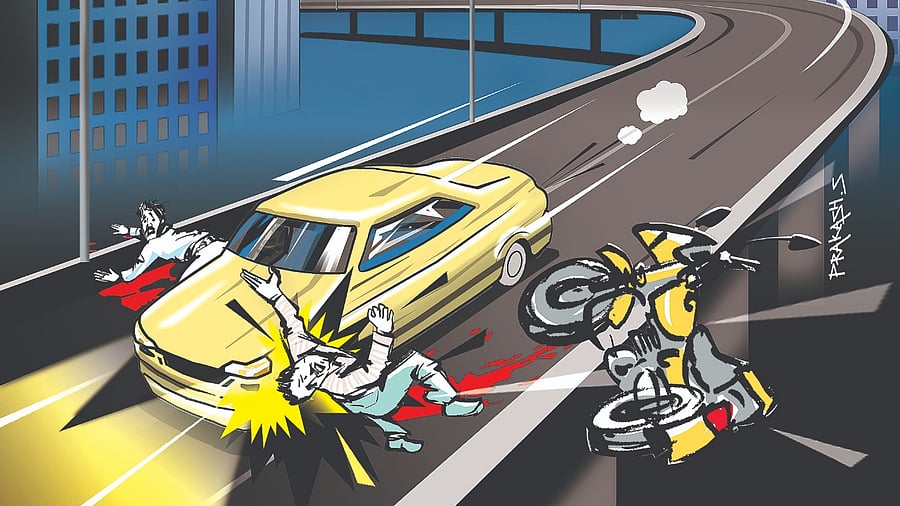

On the night of August 31, seven young people travelling in a high-end car were killed when their vehicle rammed against an electric pole near Koramangala, apparently due to over-speeding. Similarly, on the night of September 16, two youngsters on their motorcycles died when they were tossed over from the elevated flyover by a speeding car near Electronic City.
These accidents and many more occur on a daily basis and are usually due to over-speeding on roads during late night and early hours. Such accidents not only kill people but also destroy families and their dreams.
Late night speeding
In Bengaluru city, the average speed during daytime is very less. Therefore, chances of fatal accidents due to over-speeding are minimal. On the other hand, during late night and early hours, when the traffic is very less, youngsters tend to over speed, many a time resulting in serious accidents.
Since many roads in the city are signal-free corridors with a long stretch of clear road network, vehicle drivers, especially youngsters try to zoom with high speed. Generally, young people indulge in fun and pleasure by over-speeding while driving a vehicle. For many youngsters who drive high-end cars and bikes, it is a thrilling experience.
69,699 deaths
Over-speeding is one of the leading causes for road accidents in both developed as well as developing countries. According to the National Crime Records Bureau (NCRB), most of the road accidents in India were due to over-speeding, accounting for 43.7% of total accidents, which resulted in 69,969 deaths and 2,12,815 persons being injured.
Excessive speed is a key risk factor for road accidents and greater severity of the injuries in the event of a crash. In accidents occurring at higher speeds, especially of high-end vehicles, there is greater generation and transfer of mechanical energy to the affected person.
When the transfer of energy occurs to the human body in excessive amounts, damage to body organs occurs when it exceeds the physiological tolerance. The level of damage to the body is influenced by the shape and rigidity of the colliding object, along with velocity of the impact.
Scientific speed limits
In order to prevent over-speeding during late night and early hours, the traffic police and other civic agencies have initiated various engineering, enforcement and education measures. Speed limits have been fixed scientifically for different categories of road, depending on different functions of the road and its usage by various road-users.
While designing and developing roads, appropriate safeguards for vulnerable road users such as pedestrians, cyclists and two wheeler riders have been incorporated. Appropriate visible signages have been erected for better information of road users.
Automatic speed enforcement devices such as surveillance cameras and speed interceptors have been deployed by enforcement agencies on all highways and city roads. Stringent penalties such as suspension of driving licences have been included during enforcement drives.
ISA system
Increased public awareness and improved compliance towards speed restrictions have been given importance through campaigns and public education programmes. Besides, the Intelligent Speed Adaptation (ISA) system, which is popular in many Western countries, can be used to maintain safe speed levels while driving on good roads.
ISA is a system that shows great promise in terms of its potential impact on the incidence of road casualties.
With this system, the vehicle ‘knows’ the permitted or recommended maximum speed for the road along which it is travelling.
The standard system uses an in-vehicle digital roadmap onto which speed limits have been coded, combined with a satellite positioning system. The level at which the system intervenes to control the speed of the vehicle can be on the following: advisory – the driver is informed of the speed limit and when it is being exceeded; voluntary – the system is linked to the vehicle controls but the driver can choose whether and when to override it; mandatory – no override of the system is possible.
ISA may take some more time for adaptation on Indian roads and vehicles. Meanwhile, strict enforcement measures such as checking for over-speeding and drunken driving during late night and early hours may prevent fatalities on the road. Good enforcement and awareness drives may ensure prevention of accidents and greater safety on city roads.
(The author, Dr M A Saleem, IPS is Additional Director General of Police, Administration, Bengaluru)